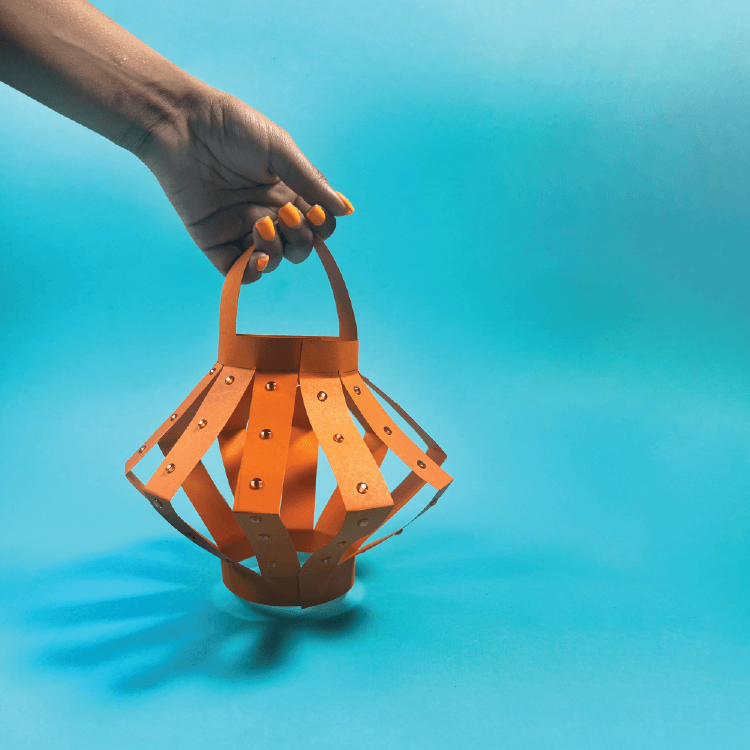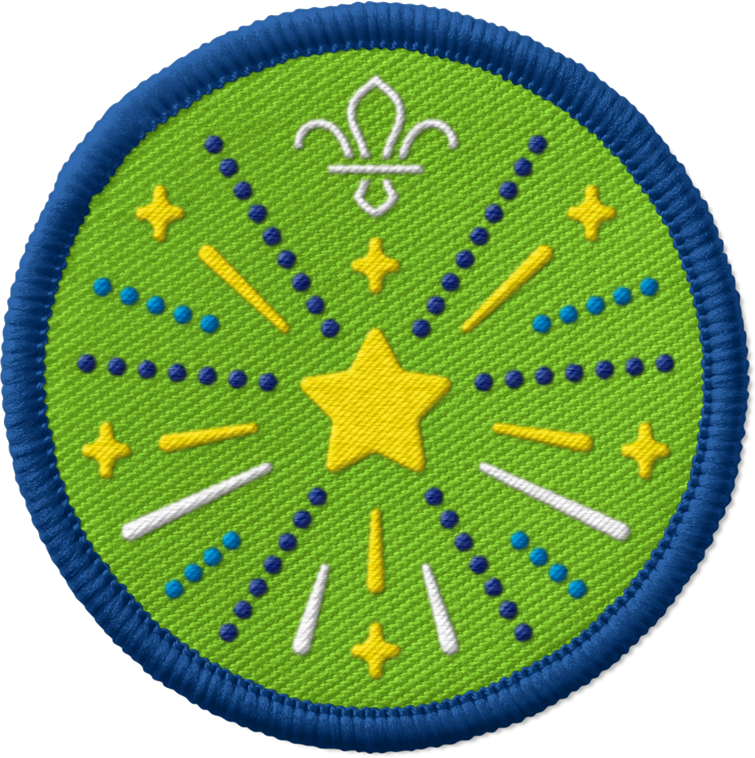
Make an Eid lantern
You’ll need
- Scissors
- A4 paper
- Coloured pens or pencils
- Rulers
- Sticky tape
- String
Scouts is open to everyone. We don’t identify exclusively with one faith, and we welcome people of all faiths and of none.
We know it’s important for people to learn about each other, including understanding different faiths and beliefs. Scouts always respects people’s beliefs, faiths and cultures, and everyone should be open to learn.
As an inclusive and values based movement, we support our members to engage and learn about different faiths and beliefs in an exciting and meaningful way, even if they don’t have a faith themselves.
Celebrating and understanding differences, including differences in faiths and beliefs, is an important part of our Scout values, which are:
- Integrity: We act with integrity; we are honest, trustworthy and loyal.
- Respect: We have self-respect and respect for others.
- Care: We support others and take care of the world in which we live.
- Belief: We explore our faiths, beliefs and attitudes.
- Co-operation: We make a positive difference; we co-operate with others and make friends.
Our value of Belief and its exploration helps Scouts to learn from other faiths and beliefs. This encourages them to develop or build their personal beliefs and understand their shared values, whether faith-based on not.
We know that learning about faiths, beliefs and different attitudes can help to break down barriers, helps us all to recognise what we have in common, and teaches us to value and respect other people. It also helps us to build up respect, acceptance and knowledge for each other, leading to a more co-operative and inclusive society.
In our diverse society, people can sometimes feel cautious talking about this sensitive subject. However, it's important that Scouts offers young people safe, exciting and open spaces to explore faiths and beliefs. They should be able to engage in personal reflection, as they question and develop their opinions and understanding of the world around them.
Making time for personal reflection and developing our beliefs means exploring the places, people, communities, celebrations or stories which hold meaning for us, and it may not necessarily mean exploring a faith.
For example, someone’s shared values may be their Scout Values and that person may choose to reflect on them at important times, such as when they make their Promise. Others may choose to reflect at certain times of the year, such as a faith-based festival, birthdays, meaningful events or at New Year. Some people may still celebrate events, such as Christmas, but use it as a time to celebrate family, friends and loved ones, as well as for charity and giving.
Discover more about Faiths and Beliefs in Scouts.
- Islam’s the second largest religion in the world. It has over one billion followers, who are called Muslims.
- There are five pillars of Islam: the declaration of faith (Shahadah), praying five times a day (Salat), giving money to charity (Zakat), fasting (Sawm) and pilgrimage to Mecca (Hajj).
- The five pillars of Islam provide a framework for a Muslim’s whole life – it’s about putting their faith first, not trying to fit their faith around the rest of their life.
- Ramadan is the ninth and holiest month of the Islamic year. It lasts for around 30 days and is measured from one sighting of the crescent Moon to the next.
- One of the pillars, Sawm, is about fasting during the month of Ramadan. Muslims fast from sunrise to sunset. Scholars agree that several groups of people aren’t required to fast, including children, the elderly, people who are menstruating, pregnant, or breastfeeding, and people who are ill.
- The nightly meal that breaks the fast after sunset is called Iftar. At the end of Ramadan, Muslims celebrate Eid al-Fitr.
Before you begin
- Use the safety checklist to help you plan and risk assess your activity. Additional help to carry out your risk assessment, including examples.
- Make sure all young people and adults involved in the activity know how to take part safely.
- Make sure you’ll have enough adult helpers. You may need some parents and carers to help if you’re short on helpers.
Introducing the activity
- Gather everyone together and ask if anyone knows what Eid is.
- Explain that Eid is celebrated in Islam. Islam’s the second largest religion in the world. It has over one billion followers, who are called Muslims.
- Ramadan is the ninth and holiest month of the Islamic year. It lasts for around 30 days and is measured from one sighting of the crescent Moon to the next. Eid al-Fitr, which means festival of breaking the fast, marks the end of fasting for Ramadan. As soon as the moon is sighted, Eid al-Fitr begins. Many people celebrate Eid al-Fitr by spending time together, exchanging gifts and visiting friends and family. This often includes eating lots of sweet food, which represents celebration - foods like baklava, dates, and Turkish delight are given as gifts. To wish someone a 'happy Eid' you say 'Eid Mubarak!'
Make the lantern
- Everyone should take a piece of paper.
- Draw a line around three centimetres in from the shorter edge of the paper. Cut off the strip and tell people to keep it somewhere safe, as it’ll become a handle later.
- Put the remaining paper face down on a flat surface so it’s horizontal, with the longest edge closest to you.
- Fold the paper in half from top to bottom to make a long strip with the undecorated side of the paper hidden inside the fold.
- Make sure the folded edge is closest to you. Draw a line about three centimetres from one edge of the paper – the line should start at the fold and extend around three quarters of the way up the paper, leaving a gap of about three centimetres at the top.
- Continue drawing lines every three to four centimetres. Make sure they start at the folded edge and extend about three quarters of the way up. Don’t worry if the last strip’s not exactly the right width.
- Cut along the lines, starting at the fold. Make sure you stop before you reach the top of the paper!
- Open up the paper. Glue the shorter sides together to make a cylinder. Add sticky tape at the top, bottom, and middle to hold it together if you need to.
- Use glue or tape to attach the handle you made in step two to the top of the lantern.
- People could decorate the lantern with pens, sequins, or other craft materials.
- Remind everyone to not use candles or flames with the lantern, as it’s a fire risk. You could use LED electrical tea lights instead.

Reflection
This activity was about sharing light, as a symbol of hope for others - what else could you do that does this? What did you learn about Eid al-Fitr that has connected with you the most? It is about reflecting on what you are grateful for, how could you do this for yourself today? What's the importance of people coming together for a celebration?
Safety
All activities must be safely managed. You must complete a thorough risk assessment and take appropriate steps to reduce risk. Use the safety checklist to help you plan and risk assess your activity. Always get approval for the activity, and have suitable supervision and an InTouch process.
- Scissors
Supervise young people appropriately when they’re using scissors. Store all sharp objects securely, out of the reach of young people.
For younger age groups, you could cut the pieces of paper in advance so everyone can get stuck into colouring or decorating their lantern and sticking it together.
Some people might need help with cutting or measuring. For those who need support with spelling you could write out the words you have just learned for them to copy them onto their lanterns.
All Scout activities should be inclusive and accessible.
Can you tell a story with your lanterns by stringing them up together?
You could try some festive foods. Try some baklava or make some biscuits in the shape of the crescent moon, or take a look at Iftar under the stars for recipes for pakoras and date shakes.
Check out our lovely activity Henna hands and learn how to decorate your hands using meaningful symbols and designs
The young people should decide what their lantern looks like and what words matter to them.


